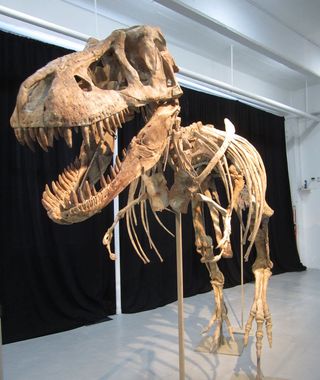Tyrannosaur Skeleton For Sale, But Ownership Is Questioned

The origin of a rare tyrannosaur skeleton, now sitting mounted and prepared at an auction house in New York City, has been questioned, with some saying the specimen is from Mongolia; if so, that would mean it entered the United States illegally.
The rare Tyrannosaurus bataar — standing 8 feet (2.4 meters) tall and 24 feet (7.3 m) long — is to be auctioned Sunday (May 20) by Heritage Auctions.
An email to LiveScience late on Friday afternoon claimed the Mongolian President Elbegdorj Tsakhia was raising concerns that the specimen was actually his country's property. The email contained a note signed by Mark Norell, a vertebrate paleontologist at the American Museum of Natural History in New York City.
"There is no legal mechanism (nor has there been for over 50 years) to remove vertebrate fossil material from Mongolia. These specimens are the patrimony of the Mongolian people and should be in a museum in Mongolia," the letter reads.
Norell confirmed that the letter was his.
The auction house stands by their collection, saying the items legally entered the United States. [Up For Auction: A Natural History Gallery]
"There is nothing from Mongolia that is legal. It's not that I am against the commercial trade of fossils, it's just different countries have different laws," Norell told LiveScience, adding that Heritage Auctions avoids giving the specific locality for the origin of the fossil in their catalog of natural history items to be auctioned.
Sign up for the Live Science daily newsletter now
Get the world’s most fascinating discoveries delivered straight to your inbox.
The description, he said, only states the skeleton is from Central Asia, though if the specimen did indeed come from China, it would still be illegal.
David Herskowitz, director of natural history for Heritage Auctions, said the T. bataar skeleton entered the United States legally, adding in a statement that "no one knows where exactly it was dug up. They'd have to find the hole and match up the matrix."
While the tyrannosaur skeleton is the headliner, several other natural-history specimens are also set to be auctioned Sunday. Of these, Norell says he is also concerned an ankylosaur skull and T. bataar teeth may also be from Mongolia; the teeth described in the auction house's catalog say they came from a formation that Norell says only exists in Mongolia.
Regarding the T. bataar skeleton and the ankylosaur, Norell said, "They say they are from Central Asia, but the only places those two animals have ever been collected have been from Mongolia." [Image Gallery: Dinosaur Fossils]
Heritage Auctions is "the third largest auction house in the country," Norell said. "I am not going to say they are complicit and aware, they are just allowing it to happen and not asking the right questions as far as provenance goes." Essentially they aren't doing their due diligence, according to Norell.
Heritage's Herskowitz said the consignors warranted in writing to Heritage that they held the title to the fossils. It is "curious that Mongolia waited until 48 hours before the auction to make their claim, when the sale has been public for four weeks," Herskowitz said in a statement.
Norell, who has worked in Mongolia for 22 years, sees more of this illegal trading occurring, as it's easier to reach the fossils now with more roads in the Gobi Desert, and the prices for the fossils are going up, he said.
"I am not against the commercial aspect," Norell said. "But it should be done ethically and it should be done legally ... it really doesn't help anybody when it is done his way"
Follow LiveScience for the latest in science news and discoveries on Twitter @livescience and on Facebook.
Most Popular


